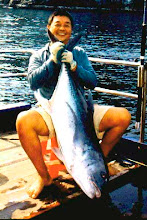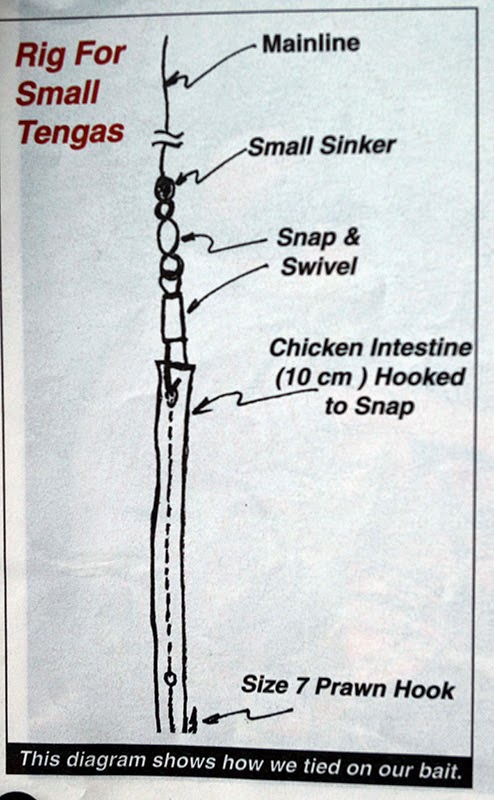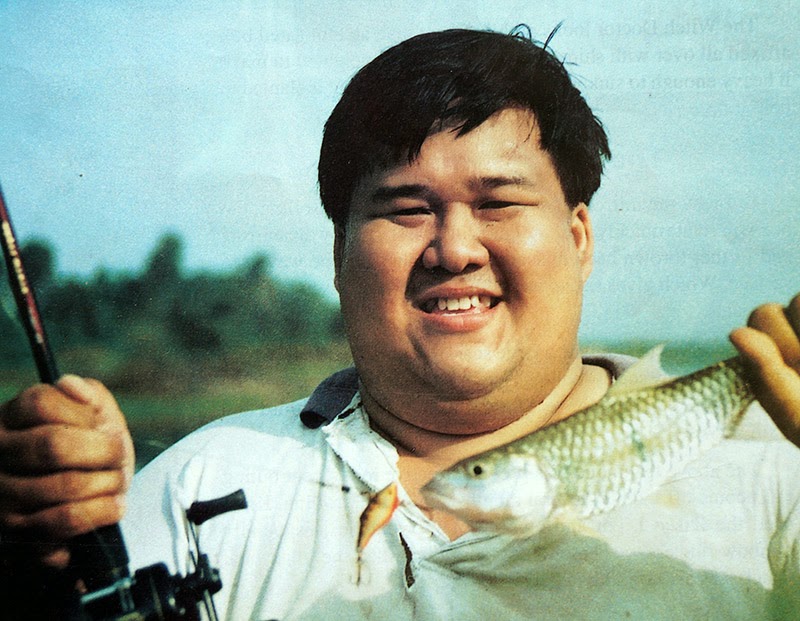 | ||
| 1. The Indonesian workers loading the harvested watermelons onto a truck. When not working, they will be going after the haruans. 2. James proudly posing with his haruan. |
I had problem seeing clearly ahead as the dust cloud thrown up by Ah Joo's 4x4 was very thick. Keeping my distance, I slowly eased my car along the dirt track hoping that its drive shaft did not give way. After forty-five minutes of bumpy ride off the Tanjung Tualang trunk road, James and I finally reached our destination. Our host and guide opened the gate into the oil palm estate (situated near the jungle fridges of Sungai Durian area) and ushered us to some workers' quarters. A short briefing later, we were let loose for our haruan fishing.
 |
| Host Ah Joo (right) and yours truly at the gate of the oil palm estate. Would you believe that this area was full of 2 kilos plus haruans and bujuks not too long ago? |
Looking around to size up the situation, I noticed that there were kilometers of flat land with not a shady tree nearby (it was a drained out swamp). James and I decided to head for some irrigation canals, dug to drain out access water away from the newly planted oil palm trees. Moving around here requires one to know hang kung (kung fu jargon for the art of light-footness). The trick was to step only onto grass clumps or dead branches. Any wrong placement would find your leg sinking into the soft porous peat soil.
 |
| Me and my haruan. The hot weather really sapped all my strength. I should have paid heed to the rumors and come here a year ago. now, only the cheroots are left. |
Casting along one such canal, I was immediately hit by a cheroot that stole my frog. Cursing underneath my breath, I moved to another canal. At the third canal, I felt a bump, lowered my rod, waited a few seconds and struck hard. That poor cheroot nearly had its dentures pulled out. It was released after its mugshot was recorded.
While casting fruitlessly at a few more canals, I met a local who just landed a presentable haruan. What Mr. Kong told me would made me regret for a long, long time to come. When this area was first opened up, haruans and bujuks of 2 kilo plus was the norm. Of course there were a lot of whoppers too. All the Indonesian workers here were having a wonderful time catching them for over a year! That was the time, one of my colleagues, Pn. Tenmoli informed me that people were catching fish in this area.
You see, her husband, Mr. Raju and his partner, Ah Joo were watermelon towkays here. They had a whole workforce, helping them plant watermelons among young oil palm trees as cash crops. As a non angler, her way of telling didn't include the exaggeration, frantic gesturing and over excitement common to story telling anglers. The true meaning of her news never really sank in. As most of my Sundays were already planned well ahead, I never made the trip here. Recently (after almost a year) when I inquired further, I was told that Ah Joo used to catch whoppers near the jungle fringing the estate. Jungle was the key word that triggered my adrenaline flow and jogged me into action. Many phone calls later, this trip was the result.
 |
| A local, Mr. Kong with his catch. |
Crossing to another part of the estate, I immediately hooked a nice haruan of about 800gms. The strikes here were more frequent and I caught a few more. At the opposite end, every time I looked to his direction, James was either fighting or unhooking haruans. Must be enjoying himself tremendously. By now my whole T- shirt was dripping wet. As there were no shade and the weather was very hot, we had got no choice but to return to the quarters to rest.
Ah Joo's wife informed us that her husband and two other friends were fishing in the swamp near the jungle fringes. Rushing over, I couldn't place where they were as the whole area was covered with tall grass. Shouting at the top of my voice a few times, I finally got a response from within the swamp.
Banging my chest Tarzan style, I plunged into the tall grass, following the trail left behind by the other guys. Panting and stumbling, I was sweating like a drowned rat. This whole area was covered by thick vegetation. Unseen tree stumps and dead branches littered the way. Every step must be taken with care as I was warned by Ah Joo earlier not to step into the water. Any misstep and the giant aquatic Daculas would home in on you.
 |
| Ah Joo jigging near the jungle fringes. |
After slipping and falling for the third time I finally emerged through the grass to find Ah Joo and gang flipping and jigging away. Looking closer, I saw water flowing underneath the grass. It was a small stream almost covered over with weeds. The trick was to flip or lower the frog into any opening, hoping that resident a haruan or bujuk was hiding below. According to Ah Joo, haruans here were more aggressive as they would come to investigate any commotion in the water. As for the lazy bujuks, they would only grab the frog if it was placed right in front of their mouths. Just like the much-coveted marble goby.
Ah Joo and gang managed to pull three haruans of respectable sizes (by current standard), before we got out from there. Itwas a pity no bujuks was caught as I wanted a photograph badly. According to Ah Joo, I should come after an overnight heavy downpour. By then all the haruans and bujuks would migrate upstream for a feeding frenzy. Those with weak hearts are recommended not to fish as the sound made by the feeding fish may cause heart attack. By now the workers were back at their quarters for their lunch break after harvesting water-melon the whole morning. Almost all of them grabbed hold of a fishing rod and headed into the swamp.
 |
| Ah Heng, one of Ah Joo's friends with another cheroot. Sigh! |






























